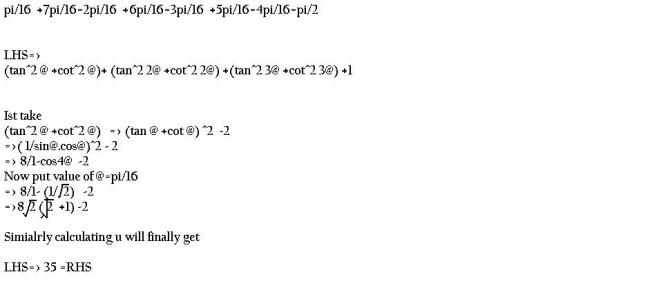An alternate way to look at the sum
S=\sum_{k=1}^{7}\tan^2\left(\dfrac{k\pi}{16}\right)
is by using complex numbers.
Consider the expansion
(\cos\alpha+i\sin\alpha)^{16}=\sum_{r=0}^{16}^{16}C_r \cos^{16-r}\alpha (i\sin\alpha)^r
The left side is same as \cos16\alpha+i\sin16\alpha%=\sum_{r=0}^{16}^{16}C_r \cos^{16-r}\alpha (i\sin\alpha)^r. So equating the imaginary parts we get
\sin16\alpha = \,^{16}C_1\cos^{15}\alpha \sin\alpha -\,^{16}C_3\cos^{13}\alpha \sin^3\alpha + \,^{16}C_5\cos^{11}\alpha \sin^5\alpha + \ldots
\ldots -\,^{16}C_{15}\cos\alpha \sin^{15}\alpha
In the expression on the RHS, pull out \cos^{16}\alpha common to obtain
\sin16\alpha = \cos^{16}\alpha \left(\,^{16}C_1\tan\alpha- \,^{16}C_3\tan^3\alpha +\,^{16}C_5\tan^5\alpha-\ldots -\,^{16}C_{15}\tan^{15}\alpha\right)
which after slight modification I write down as
\sin16\alpha = -\tan\alpha\cos^{16}\alpha \left(\,^{16}C_{15}(\tan^2\alpha)^7- \,^{16}C_{13}(\tan^2\alpha)^6 +\ldots +\,^{16}C_3(\tan^2\alpha)-\,^{16}C_1\right)
If we now set the value of \alpha%\sin16\alpha = -\tan\alpha\cos^{16}\alpha \left(\,^{16}C_{15}(\tan^2\alpha)^7- \,^{16}C_{13}(\tan^2\alpha)^6 +\ldots +\,^{16}C_3(\tan^2\alpha)-\,^{16}C_1\right), one by one as \dfrac{k\pi}{16}%\sin16\alpha = -\tan\alpha\cos^{16}\alpha \left(\,^{16}C_{15}(\tan^2\alpha)^7- \,^{16}C_{13}(\tan^2\alpha)^6 +\ldots +\,^{16}C_3(\tan^2\alpha)-\,^{16}C_1\right) for k = 1 to 7, then we see that the numbers \tan^2\left(\dfrac{k\pi}{16}\right)%\sin16\alpha = -\tan\alpha\cos^{16}\alpha \left(\,^{16}C_{15}(\tan^2\alpha)^7- \,^{16}C_{13}(\tan^2\alpha)^6 +\ldots +\,^{16}C_3(\tan^2\alpha)-\,^{16}C_1\right) are the roots of the equation
\,^{16}C_{15}x^7- \,^{16}C_{13}x^6 +\ldots +\,^{16}C_3x-\,^{16}C_1=0
As such their sum
S=\sum_{k=1}^7\tan^2\left(\dfrac{k\pi}{16}\right)=\dfrac{^{16}C_{13}}{^{16}C_{15}}=\boxed{35}
which the required answer.
pls solve
1)Σtan2(rΠ/16)=S and r varies from 1 to 7 wat is S?
2)let f(x+y)=f(x)2+f(y) for all x,y belongs R then find f(x)
3)If two distinct circles x2+y2-2ax+c=0 and x2+y2-2bx+c=0 and a2>c b2>c>0 cut equal intercepts on a straight line whose slope is -1 then the line is tangent to
x2=2(a+b)y and y2=2(a+b)y
i have done this one but i want a method which can be completed within 3 mins.
4)if (x2-5x+3)(1+y+y2)<2y for all y belongs to R.Then find the values of x satisfying the ineqality.
-
UP 0 DOWN 0 1 9

9 Answers
For Q2), setting x=y=0 in the functional equation, one gets
f(0)=f(0)2+f(0) => f(0) = 0.
Next, set y =0 to obtain f(x) = f(x)2 + f(0)
which gives f(x) = f(x)2
This implies that for all real x, either f(x)=0 or f(x)=1. But if f(x)=1 for all x, then we get f(0)=1 which is a contradiction. Hence, for all real x, we get f(x)=0.
sir thanx for the second qn thanx for the time saving solution for the first one,Actually these qns were in a qn paper and i cant complete within 3 min i postd thanq eure for ur gud work.
actually i got the same f(0)=0 and f(x)=1 or 0 but i havent interpreted these three.
http://www.goiit.com/posts/list/trignometry-trigonometry-62432.htm#312808
though in hindsight, tan2 k π16 for 1≤k≤7 are the roots of the equation obtained by putting tan2θ = t. So we directly obtain the required sum as 16C13 = 35
4) We first have to find the least possible value of \frac{2y}{1+y+y^2} = \frac{2}{1+y + \frac{1}{y}}
This is will obviously occur when y<0.
When y<0, we have y + \frac{1}{y} \le -2 \Rightarrow 1 + y + \frac{1}{y} \le -1 \Rightarrow \frac{2}{1+y + \frac{1}{y}} \ge -2. So the least value obtained by RHS is -2.
So, we just have to solve the inequality x2 - 5x + 3 <-2
or x2-5x+5 <0 which is true for the interval
\left( \frac{5 - \sqrt 5}{2}, \frac{5 + \sqrt 5}{2} \right)
The roots of the quadratic x2 - 5x + 3 are \alpha = \dfrac{5+\sqrt{13}}{2} and \beta = \dfrac{5-\sqrt{13}}{2}
Ifx\in (-\infty,\,\beta)\cup (\alpha,\,\infty),, then the expression x2 - 5x + 3 > 0. Treat the given inequality as a quadratic in y. Then, we require that for all real y
(x2-5x+3)y2 + (x2-5x+1) y + (x2-5x+3) < 0 -------(1)
But this is not possible since the coefficient of y2 being positive, the parabola opens upwards so there will be some y for which it will be positive.
Hence,\beta < x < \alpha. Now the coefficient of y2 is negative and so in order for (1) to be satisfied for all y, we require the discriminant of (1) to be negative:
(x^2-5x+1)^2-4(x^2-5x+3)^2<0
which imples
(x^2-5x+5)(3x^2-15x+7)>0
This yields
x\in \left(-\infty,\, \dfrac{15-\sqrt{141}}{6}\right)\cup \left(\dfrac{5-\sqrt{5}}{2},\,\dfrac{5+\sqrt{5}}{2}\right)\cup \left(\dfrac{15+\sqrt{141}}{6},\infty\right)
Using the fact that \beta < x < \alpha, we get the required values of x by taking intersection:
\boxed{x\in \left(\dfrac{5-\sqrt{5}}{2},\,\dfrac{5+\sqrt{5}}{2}\right)}
